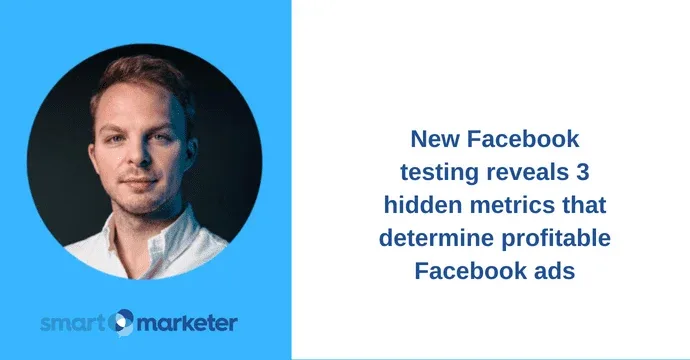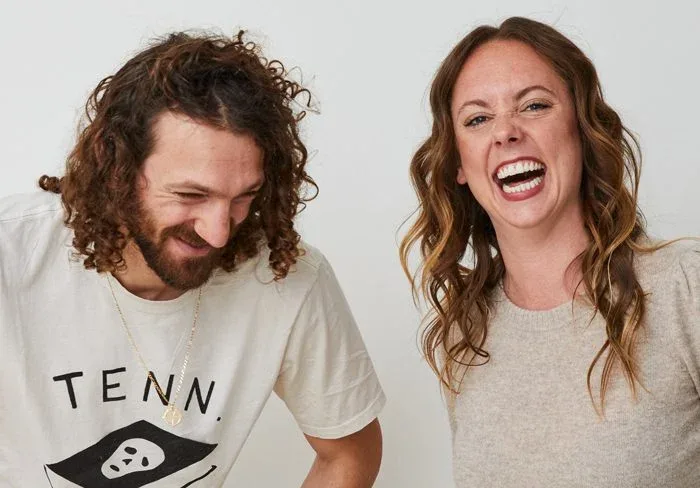Did you know there are 3 underused Facebook metrics that can make your campaigns far more profitable?
Well, it’s true!
I’ll reveal these 3 metrics in just a moment. But first, some context…
Since launching the Smart Marketer Agency last year, we’ve tested a lot of different ads for our clients — and I mean a lot.
Because of the number of ads we’ve tested, we were able to dive much deeper into our clients’ Facebook metrics. And these little-known metrics have allowed us to discover what makes an ad truly successful.
See, when Facebook marketers only rely on CPA, they’re leaving money on the table. Don’t get me wrong — CPA is very important…
But when you understand these other metrics, that’s when Facebook ad campaigns really take off.
We discovered them while working with our 7, 8 and 9-figure clients, so these metrics are proven, and can make your campaigns far more profitable.
So what are these 3 metrics?
The great ROAS myth (and what to use instead)
Let’s look at the first metric: New Customer ROAS.
When you take the general ROAS metric, it’s NOT giving you an accurate picture.
Why?
Because it will include returning customers in your figures, whereas we want to know the normal ROAS figure, as well as knowing the new customer ROAS figure.
When you drill down and understand these two figures, then you know what you can spend to acquire a customer. And this is where knowing the lifetime value of your brand’s customers is vital.
When you have customers with high lifetime value, then you can afford to break even (or even lose a little) on the first purchase, because profit will come from sales on the backend.
On the other hand, if you have low lifetime value then you may need to prioritize making a profit on the first purchase.
That’s why knowing your new customer ROAS is so crucial.
However, you might think the CPA or AOV (average order value) are more important metrics. If this is the case, then consider this:
If you increase your lifetime value of a customer, then your CPA can go much higher, and you can spend more to acquire a customer.
Then there’s this scenario: you increase your AOV on that first purchase. That means that your CPA can go up, but your new customer ROAS might stay the same.
So just looking at CPA or just looking at AOV is not always the right approach. Because eventually it really comes down to your new customer ROAS.
There are multiple ways to look at new customer ROAS. They all have their benefits and downsides, but one way is to look at your Facebook Ads Manager.
Are you using this third party tracking tool?
Looking at your campaign it can exclude your buyers and your previous purchases. Now look at what the ROAS is on those ads.
However… there might be a problem.
Since the iOS update, Facebook has had tracking issues. As a result, it’s not 100% accurate.
And sometimes the exclusions are not perfect. So you might have existing customers buying from these ads.
This means you might need to use a third-party tracking tool such as Triple Whale. This will give you what your new customer CPA and new customer ROAS actually are.
And the last way to look at new customer ROAS is the blended formula.
You do this by:
- Adding up all ad spend.
- Looking at your new customer revenue.
- Then dividing new customer revenue by the number of new customers.
Recently, I audited an ad account, and they only had a CPA goal for their overall business. They were neglecting new customer ROAS. Whereas this figure is actually more informative than a general, blended CPA figure.
Another client had a certain CPA goal based on their past performance in the last few years. Their CPA and new customer ROAS was much lower back then.
We changed the offer, and started running ads to a higher priced offer. This meant our new customer ROAS was higher, and the new customer’s CPA was also much higher.
But maybe your business is already doing 8 figures and you haven’t done that with direct response ads. That means that you’re already getting a lot of new customers, even if you have zero ad spend.
So you can see that if you’re an established brand you can still use the blended ROAS formula.
Here’s what you do…
- Set an average baseline of new customers that you’re already generating. (For example, let’s say your average baseline of new customers right now is 20 customers a day.)
- Then calculate new customer ROAS based on the new customers after the first 20 you’re already getting.
- By calculating from 21 onwards your new customer ROAS will be much lower than if you blend it.
But what if you’re generating hundreds of new customers every day?
If this is the case, then look at using a third-party tracking tool.
You can still look at the blended ROAS and try to find some correlations with what you’re doing, but when you have around 100 new customers a day, it becomes much more challenging to see the direct effect of your ads and new customer ROAS. So you may not want to rely on the Ads Manager.
Your Bonus Tip
And a bonus tip for you; if you’re making 7+ figures, I would suggest you take out view-through attribution as well, both in the Ads Manager and the third-party tracking tools.
That’s because you probably already have a lot of new customers that are intending to buy.
Here’s what happens: Facebook or Instagram shows the ads. And the clients are already planning to buy, but because of the 24 hour view-through attribution, it means Facebook still shows them an ad, and the client buys within 24 hours.
They haven’t clicked on the ads, but the ads will still get the attributed purchase. And this is NOT always super accurate.
4x ROAS
Some of our clients have strong brand recognition.
These clients can see 4x ROAS, and this is when we add the view-through attribution figure.
This is probably an indication that view-through attribution is not super accurate and also not relevant. In this case we only look at the clicks.
How you know you’re running effective ad headlines
But let’s go onto the second metric: the See More rate.
The See-More rate tells us if our ad headlines are effective, and shows you whether the first three lines of our ads and creative are capturing attention. The See-More rate will be different according to our creatives.
Here’s a quick story.
I was running an ad from Molly’s page for a workshop.
It was an image of me standing next to a whiteboard with some copy that said; “Hi, my name is Pep. I run Molly’s and Smart Marketer’s ads and a bunch of other accounts. Join the workshop to see what is working right now. P.S., obviously not a designer.”
That image was just taken with an iPhone.
We also ran another ad with a headshot of me, and the copy said: free workshop, the state of paid advertising, etc.
The interesting thing was that the See More rate was 1.97% for the first image and 0.58% for the second image.
It goes to show that using different copy and creatives can give different results.
Attention versus CTR
The See More rate gives you a metric for attention.
But you also have to look at click-through rate, because if your See-More rate is good while your click-through rate is really low, it means that you’re getting curiosity attention versus qualified attention.
This is important: if you ad shows the See More… and people click to unfold your ad… but then don’t live up to what you’re saying or showing in the creative… or the first three lines of your ads doesn’t ‘grab them’… then the people will drop off. And that means that you’re getting the wrong type of attention.
The formula for the See More rate is clicks, minus link clicks, post reactions, post comments, and post shares, then divide this total with the number of impressions.
You can discover my formulas on my Twitter feed. More on that in a moment.
How to turn under-performing video ads into winners
Lastly, the third metric is the Thumb-Stop rate.
This is only used for video ads. The Thumb-Stop rate indicates how many people watched at least the first three seconds of the video ads.
We’ve discovered a good Thumb-Stop rate is 30%.
Here’s a great tip to improve your Thumb-Stop rate: overlay a headline on the thumbnail of a video. We saw a big difference when we used a different headline on a video ad for a client.
We were running ads for Arrae, a sleep supplement, and here’s what we did:
- We added a text headline on the thumbnail – “The key to catching Zs.”
- For the second image we added a headline – “Looking for alternatives to counting sheep?”
- And the third headline was “Deep sleep without the daytime drowsiness.”
The results were fascinating.
The first one — the key to catching Zs — was 27%.
The second headline was 22.32%.
And the last headline had a Thumb-Stop rate of 37.24%. This was the winner.
I think that the Thumb-Stop rate is a great way to test if you can get more attention with the same video and creative.
You only need to change the thumbnail, so it’s an easy way to catch the attention of a different type of person. This way you can basically scale up your ads, because that is what profitable Facebook marketing is all about.
How we can reach different types of people by using different thumbnails. This way we can spend more on ads and have more ads running at the same time.
Your Bonus Metric
Now I’m going to give you a bonus metric: conversion rate.
Yes I know you already study this number like crazy, but here’s the thing:
When you create the conversion rate metric in Ad Manager you’ll see different conversion rates. These are:
- Conversion rate for your site
- Conversion rate per campaign
- Conversion rate per ad set
- Conversion rate per ad
Knowing each of these conversion rates allows you to spot any weak spots in your campaigns.
For instance, you need ads that lead in a logical path to your opt-in or sales page. If you have a high click-through rate but a low conversion rate then generally your sales page needs improving.
But…
The problem might be the quality of your clicks, that’s because your ads might be generating curiosity but don’t get people in the right mindset to take the next action to either opt-in or buy.
How to spot weak ads and make them profitable
One way to determine your individual ad conversion rates is: look at the purchases then divide by landing page views. By studying your conversion rates you’ll be able to spot weak underperforming ads, and make them more profitable.
To summarize, you now have four metrics you can use to determine why certain ads are more successful and certain ads are not successful.
These are 3 important metrics that we use on a daily basis in our agency for our clients. These 3 metrics have made these clients even more profitable, and they can make your campaigns more profitable as well.
If you want to see these metrics and formulas, I posted them on my Twitter page. I’ll pin the post on my Twitter and I’ll show you how you can create these metrics and how you can add them in your Facebook Manager so that you can actually use them.
And if you want to step up your game this year, then you can now register (or join the waitlist) for Train My Traffic Person.
Check this link out right now. You’ll reap the benefits for years to come.





